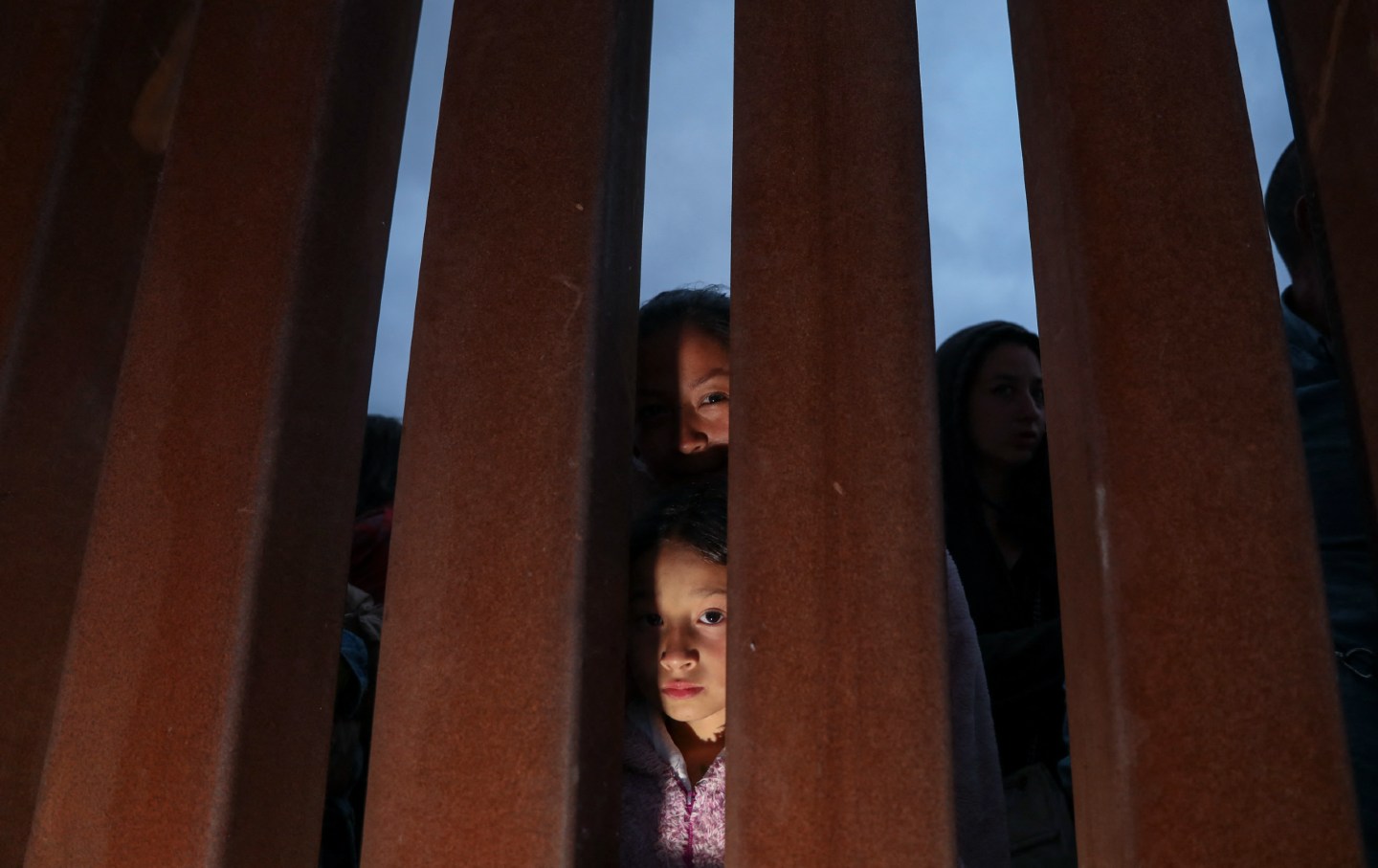11 Arguments for Open Borders
A world not divided by militarized borders would help form a world where sustainability and justice take precedence over extraction and exploitation.

Migrants wait for asylum hearings at the US-Mexico border on May 10, 2023, as seen from San Ysidro, Calif.
(Sandy Huffaker / AFP via Getty Images)Most arguments for open borders begin by addressing counterarguments, trying to assuage fears of overcrowding, overrun public services, tanking economies, or generalized chaos. It’s important work; careful counterarguments can deflate nativist fearmongering. The case for open borders, however, must also be a positive one, explaining why the freedom to move—coupled with the freedom and possibility to remain—is a necessary good, and why a world not divided into exclusive nation states with militarized borders would be more egalitarian, would promote and cultivate diversity, and would help form a world where sustainability and justice take precedence over extraction and exploitation.
When we open borders, there won’t be an overwhelming influx of migrants, wages won’t plummet, there won’t be a paralyzing run on government services, and crime won’t increase. All true—but policies are rarely won by defining what they won’t do.
Unauthorized migration, whether it is asylum seekers fleeing for their lives or the poor for better opportunity, should be understood as a radical political act. It is an individual act often driven by necessity, but it is also a subversion of a violent system. Colonizers in the United States saw themselves, and were celebrated, as subjects bucking oppressive rule. Today’s migrants, exercising their fundamental right of mobility, are migrating in a much more peaceful manner than the settlers and colonizers of yore. Today’s migrants are not threats to freedom, but much-needed threats to a global system of oppression. In their mere movement, they are freedom fighters.
Opening borders is possible. A necessary step toward guaranteeing and exercising the right to free movement includes understanding its implication and promises. Below is a far from exhaustive list of some of the simple arguments about why open borders would be an economic, environmental, and ethical boon.
1. Borders Have Not Always Been
Historically speaking, closed borders are still in short pants. For the first century of the United States’ existence, there were zero federal immigration laws, and there were no substantial fences or walls along the US-Mexico border until the late 1990s. Immigration scholar Reece Jones calculates that as recently as 1990 there were only 15 international border walls throughout the world. That number today is likely in the 80s. But change works in both directions, and the number may soon fall back to 15, or to zero.
Borders haven’t always been. And they certainly haven’t always been as they are now—militarized zones where human beings are stripped of their rights merely for crossing an imaginary line. Nor will borders, as they are now, always be.
2. Immigrants Don’t Steal Jobs—They Create Them
Economic studies across the political spectrum tell us that immigrants create more jobs than they take, and that the ones they do snag are essential for the basic functioning of much of Western society. A US Department of Labor study conducted under the Bush administration noted that the perception that immigrants take native jobs is “the most persistent fallacy about immigration in popular thought.” A comprehensive 2016 report from Cornell University found that migration resulted in “little to no negative effects on overall wages and employment of native-born workers in the longer term.”
Much of the confusion comes from the “lump of labor” fallacy, which the Cato Institute defines as the “fundamental misconception that there is a fixed amount of work in a society.” As economist Jonathan Portes explains, “It’s true that, if an immigrant takes a job, then a British worker can’t take that job—but it doesn’t mean he or she won’t find another one that may have been created, directly or indirectly, as a result of immigration.”
British Revenue and Customs figures show that from 2013 to 2014, recent arrivals to the United Kingdom paid £2.54 billion more in income tax and national insurance than they received in tax credits or child benefits. The UK’s Office of Budget Responsibility has estimated that migrants’ labor contribution is helping to grow the economy by an additional 0.6 percent a year. That economic growth equals more jobs all around.
3. Immigrants Don’t Drain Government Coffers
In 2016, immigrants contributed an estimated $2 trillion to the US GDP. Two years later, economists tabulated that immigrants added over $450 billion to state, local, and federal taxes. The same year, immigrants wielded more than $1.2 trillion in spending power in the United States, by which they purchased groceries, clothes, cars, homes, appliances, and all sorts of useful and useless goods from both local and big businesses. Meanwhile, proposed cuts to US legal immigration, economists estimate, could tank GDP by 2 percent over 20 years, shrink growth by over 12 percent, and eliminate more than 4.5 million jobs. American Rust Belt states would be hit particularly hard, as they rely on immigration to stabilize populations and revive economies.
For all they pour in, immigrants can’t collect on a lot of public services and tend to use the ones to which they do have access much less than natives. For instance, according to a 2015 study, immigrants use emergency room services at half the rate of native residents.
In the United States, authorized migrants must pay into the welfare system for at least five years before they can draw any benefits. Studies have estimated that migrants to the United States pay tens of billions more in payroll taxes than they receive in Social Security benefits. Unauthorized migrants, meanwhile, almost exclusively pay into the pot—unable to draw much of anything out.
Immigrants don’t hurt the economy, though they are often hurt by the economy.
4. Borders Don’t Stop Crime and Violence; They Engender Crime and Violence
In 1917, as some of the first lengths of wall and fence were being raised along the US-Mexico border, and as emergency measures were put in place to limit migration, a new law increased the head tax at the border to $8 (equivalent to $162 today) and, for the first time, expanded the tax to Mexican citizens. As Reece Jones notes, “The result was the emergence of smuggling networks, which would take people across the border for half that amount, saving the laborers money.”
For over a century, increased immigration enforcement and border militarization have led to expanded and more profitable smuggling networks. Prohibitions against drugs (including alcohol) and anti-immigration crackdowns created the ultraviolent transnational paramilitary networks that have plagued large parts of Mexico, Central and South America, and border regions throughout the hemisphere for decades. State forces and politicians criminalize drugs and migration even as they back and create criminal networks that traffic drugs and migrants, accept bribes, and contribute to a spiral of violence that has, in Mexico alone in the last 20 years, resulted in the deaths of nearly half a million people and the disappearance of almost one hundred thousand more. The border has not kept the crisis at bay; it has helped to create it.
Popular
“swipe left below to view more authors”Swipe →Legalizing migration and drugs would—overnight—eliminate nearly all the profits on which transnational criminal groups rely and free up the piggish immigration and drug-enforcement budgets to address the root causes of addiction and forced migration.
5. Immigrants Don’t Threaten Communities; They Revitalize Them
When migrants arrive to a community, crime rates drop, property values jump, and neighborhoods get a shot of cultural energy and economic vitality. There are exceptions, of course, and xenophobes have made much hay out of particular cases when, for example, an unauthorized migrant commits a violent crime. After the 9/11 attacks, the United States specifically targeted and criminalized Muslim migrants, reframing immigration as a national security issue. But of the 180 people arrested for plotting terrorist attacks in the United States in the two decades following 9/11, only four were found to have illegally crossed US borders. Three crossed the US–Mexico border, but when they were children younger than 5—one wasn’t even a year old. Their radicalization (though they did not commit any actual attacks) took place in the United States. No one has ever been killed in a terrorist attack on US soil by anyone who illegally crossed the US–Mexico border. One study calculated the chance of an American being killed in a terrorist attack by a refugee is about 1 in 3.86 billion.
It’s not just about national security but neighborhood security as well: Researchers found that first-generation Mexican immigrants are 45 percent less likely to commit a violent offense than third-generation Americans. “For every ethnic group without exception,” write Rubén Rumbaut and Walter Ewing in a 2007 study that has been replicated many times since, “incarceration rates among young men are lowest for immigrants, even those who are the least educated.” A 2021 Axios study found that while crime rates shot up in many cities throughout the country, violent crime rates in 11 of the largest communities along the US–Mexico border stayed below the national average. A 2018 study in the journal Criminology found that “increases in the undocumented immigrant population within states are associated with significant decreases in the prevalence of violence.”
6. Migrants Rejuvenate
Many US cities—St. Louis, Detroit, Philadelphia, Cleveland, Baltimore, Buffalo, New Orleans, Pittsburgh, Newark, Milwaukee—have been emptying out in recent decades. In his book One Billion Americans, journalist Matthew Yglesias calls for repopulating the “hard-core depopulation belt composing about a third of rural counties that currently have fewer residents than they had in 1950.” These cities, suburbs, and rural areas could use new workers, more taxpayers, and the revitalizing spirit immigrants bring everywhere they go.
Not only does the United States need more migrants—the current US fertility rate is below the number of births per woman needed to maintain a steady population—but it has more than enough room to welcome them. With just an average of 86 people per square mile, the United States is far less dense than many other countries throughout the world. And only about 5 percent of US land is developed. The country could quadruple the population and still be less dense than France.
None of this is to promise unwavering homogeneity. If more migrants came, your city would change, but that’s what cities do. In 1920, New York City’s population was 44 percent immigrant. The same year, Cleveland was 41 percent immigrant. (Today those numbers are about 36 and 6 percent, respectively.) Those cities thrived in subsequent decades, and when people today pine for those cities’ heydays, they are pining for immigrant cities.
7. Open Borders Doesn’t Mean a Rush to Migrate
Across the globe, about 14 percent of the global population—around 700 million people—would, according to recent Gallup polls, like to migrate. Financial burdens, family ties, and fear of the unknown, however, keep a lot of them at home. Plus, many of those potential migrants wouldn’t migrate in the same direction. Despite the lure of the Hollywood-baked American dream and economic and political pressures in “sending countries,” most people want to stay at home. Eastern European countries added to the EU free-migration zone did not swarm Western European countries with their citizens. Absent lethal climactic or political threats, most people tend to want to stay where they are.
A recent study of Central Americans who participated in a poll asking whether they want to migrate to the United States found that only 3 percent of those who responded positively actually made preparations to head north. (It is unclear how many, in the end, ventured from their homes.) This means, if we return to the polls cited above of total potential migrants worldwide, probably only about 21 million of those 700 million people who want to migrate actually would, which is a much more absorbable quantity, especially when spread throughout receiving countries. And even given that the closed-border regime may have convinced many of those people to stay at home—and some of them may, with open borders, venture forth—migration is still expensive and uprooting, and many people don’t want to leave their homes, jobs, families, language, and community.
8. Closed Borders Are Unethical
In The Ethics of Immigration, political theorist Joseph Carens writes that birthright privileges, or jus solis—unearned preferential access to wealth, freedom, quality healthcare, and myriad other benefits—are akin to feudal class privileges, in that they grant “great advantages on the basis of birth but also entrench these advantages by legally restricting mobility, making it extremely difficult for those born into a socially disadvantaged position to overcome that disadvantage, no matter how talented they are or how hard they work.”
Besides bestowing or withholding privileges and interrupting reciprocity, closed borders subject some people, based on where they were born and what visas or passports they are granted, to prolonged detention, torture, isolation, removal from family, and deportation—all for an act that is quintessentially human: moving toward safety, freedom, or opportunity. It is hard to see an iota of ethics in such a setup.
9. Opening Borders Is Economically Smart
“When it comes to policies that restrict emigration, there appear to be trillion-dollar bills on the sidewalk,” economist Michael Clemens famously wrote in 2011. “For eliminating labor mobility barriers, the estimated gains range from 50 to 150 percent of global GDP.” As of late 2021, the global GDP is over $80 trillion, which means open borders would, according to his reckoning, add $40–100 trillion in total global wealth.
Clemens’s estimated potential windfall is almost certainly overblown, mostly because it assumes a much higher rate of migration that would likely occur, and it also likely undercounts downstream changes to productivity rates, as well as the basic costs of massive migration. But his point still stands: Opening borders would both increase wealth and distribute wealth more equally. With open borders, hunger, homelessness, and other forms of poverty, privation, and precarity would decrease. In 2017, the nonprofit ProPublica found that for every 1 percent increase in US immigrant population, GDP rises 1.15 percent.
In addition, economists have observed up to 1,000 percent wage gaps for workers doing nearly identical jobs between the United States and Haiti, Nigeria, or Guatemala. It’s hard to argue against the decision to go from earning less than $5 a day to $15 an hour for doing the same labor, and yet the Haitian, Nigerian, or Guatemalan worker is forced to risk their life to do so. Such wage gaps are not an inevitable part of the economic order. Rather, they are intentionally enforced and exploited.
The open-borders-for-capital and closed-borders-for-people schema is a lose-lose for workers. Corporations use borders as a wedge to lower wages and undercut labor protections everywhere. Opening borders would immediately strip corporations of this leverage, offering workers easier access to decent wages and facilitating collaboration and collective organization.
10. Open Borders Are an Urgent Response to the Climate Crisis
According to prevailing estimates, as many as half a billion people will be forced from their homes by climate crises in the coming decades. Consigning them to refugee camps or slums would be dangerous for them and us as well as a disgraceful mark of ignominy on the world. Tens of millions of people amassed behind border walls will push us closer to political despair and explosive violence. As we work toward sustainability, as we work toward survivability, opening borders is an essential step not only toward keeping people safer from the accumulating disasters but also to finding a collective solution.
The United States, Germany, Japan, the UK, Canada, France, and Australia collectively spent more than twice as much on border and immigration enforcement (over $33.1 billion) as on climate finance ($14.4 billion) between 2013 and 2018. Despite the major world powers’ spending significantly more on border enforcement than decarbonization or mitigation efforts, any hope for a solution continues to recede. Closed doors don’t cool or calm an increasingly hot and erratic climate. Nor do they lock in place an upheaved global population.
11. The Right to Migrate / The Right to Remain
Humans are a mobile species. We are also a nostalgic species, forging ties and identities based on place. The two truths can conflict, but they don’t have to. Showing respect, addressing injustices, and offering welcome can help guide us toward a more just and less violent future.
More on Immigration
Who the land “belongs” to is, always has been, and always will be a source of contention. Indigenous people deserve apology and compensation for the massive and murderous robbery of the past centuries, but that doesn’t necessarily mean drawing and enforcing new borders. Rather, we need to wholly reconsider our relationship to land, embracing the spirit of a shared commons—commons, that is, in the sense proffered by scholar-activist Silvia Federici: “not as a gated reality, a grouping of people joined by exclusive interests separating them from others, as with communities formed on the basis of religion or ethnicity, but rather as a quality of relations, a principle of cooperation and of responsibility to each other and to the earth, the forests, the seas, the animals.” Workers and anyone who cares for rather than exploits or destroys the land should be permitted to enjoy and live on and in the land.
Humans have always been roaming, curious, and on the run. It is only modern nation states and the machinery of borders that have turned our innate and natural mobility into migration, into something visa-stamped and permitted, or deemed illegal and punished. As migration scholar Nicholas de Genova has put it, “If there were no borders, there would be no migrants—only mobility.” A surprisingly easy way to eliminate illegal migration would be—simply—to eliminate closed borders.
But the appeal for open borders rings empty without the attending fight to improve conditions in the countries migrants flee. Nobody should be forced to migrate—whether it be due to state violence or oppression, climate change or the inability to find employment. One of the essential aspects of the push for open borders is the push for a more just and safe world, a world in which nobody is driven out of their homes because of fear or want.
An open-borders vision is one where such a life is not constrained by where that community lies, or where one is able to seek or find such a community. An open-borders world is a world in which “this” and “that” side of the border are not distinguished by violence on this side and safety on that side, by prosperity and opportunity spatially juxtaposed by poverty and choicelessness.
Disobey authoritarians, support The Nation
Over the past year you’ve read Nation writers like Elie Mystal, Kaveh Akbar, John Nichols, Joan Walsh, Bryce Covert, Dave Zirin, Jeet Heer, Michael T. Klare, Katha Pollitt, Amy Littlefield, Gregg Gonsalves, and Sasha Abramsky take on the Trump family’s corruption, set the record straight about Robert F. Kennedy Jr.’s catastrophic Make America Healthy Again movement, survey the fallout and human cost of the DOGE wrecking ball, anticipate the Supreme Court’s dangerous antidemocratic rulings, and amplify successful tactics of resistance on the streets and in Congress.
We publish these stories because when members of our communities are being abducted, household debt is climbing, and AI data centers are causing water and electricity shortages, we have a duty as journalists to do all we can to inform the public.
In 2026, our aim is to do more than ever before—but we need your support to make that happen.
Through December 31, a generous donor will match all donations up to $75,000. That means that your contribution will be doubled, dollar for dollar. If we hit the full match, we’ll be starting 2026 with $150,000 to invest in the stories that impact real people’s lives—the kinds of stories that billionaire-owned, corporate-backed outlets aren’t covering.
With your support, our team will publish major stories that the president and his allies won’t want you to read. We’ll cover the emerging military-tech industrial complex and matters of war, peace, and surveillance, as well as the affordability crisis, hunger, housing, healthcare, the environment, attacks on reproductive rights, and much more. At the same time, we’ll imagine alternatives to Trumpian rule and uplift efforts to create a better world, here and now.
While your gift has twice the impact, I’m asking you to support The Nation with a donation today. You’ll empower the journalists, editors, and fact-checkers best equipped to hold this authoritarian administration to account.
I hope you won’t miss this moment—donate to The Nation today.
Onward,
Katrina vanden Heuvel
Editor and publisher, The Nation








